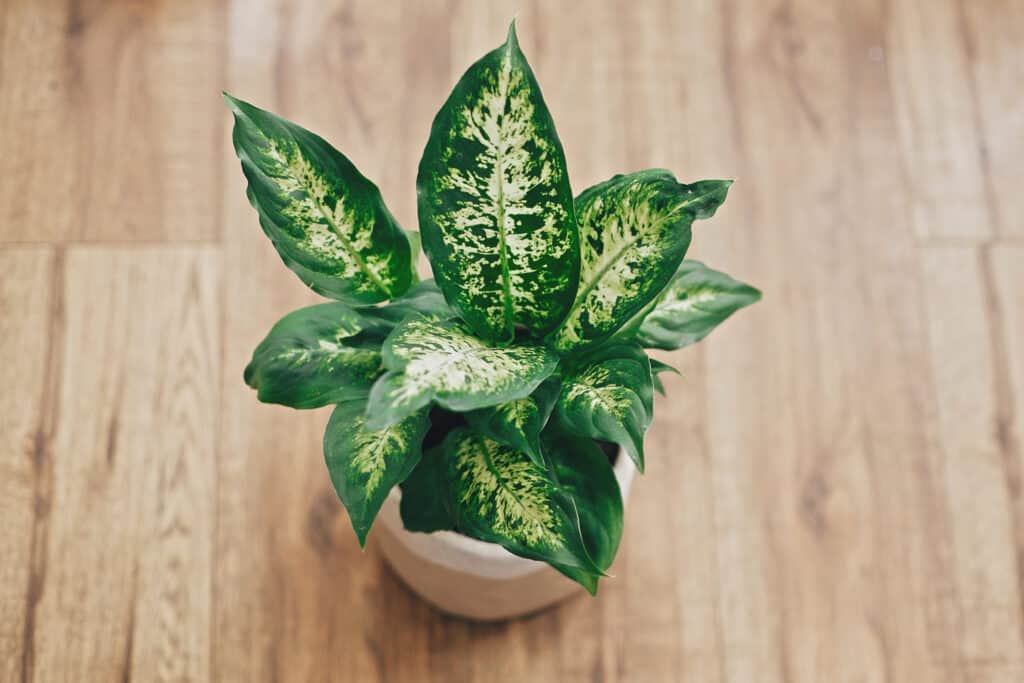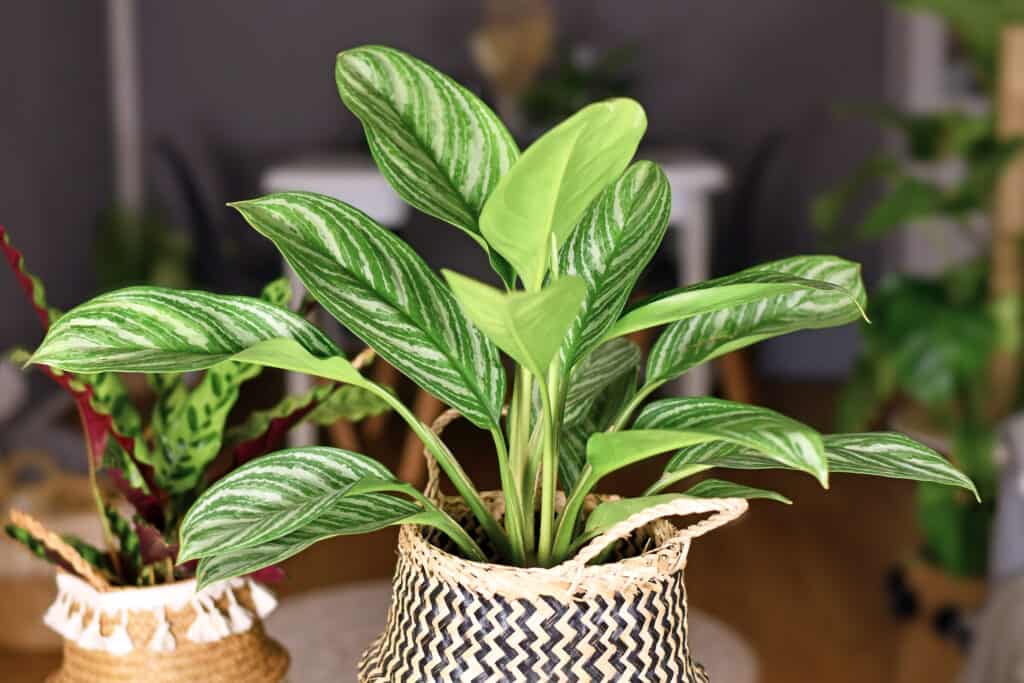Dieffenbachia (Dumb Cane) and Aglaonema (Chinese Evergreen) are two popular genera of flowering plants belonging to the Araceae family. Both are commonly used as indoor plants due to their colorful, tropical foliage and shade-tolerant properties.
Many gardeners have trouble differentiating between the two, as both tend to produce elliptic leaves with mottled patterns in various shades of green. Moreover, as the two are closely related, they share similar care needs and almost identical ideal growing conditions.
In this article, we’ll provide you with the key differences between the Dumb Cane and the Chinese Evergreen. We’ll go over what makes each unique and cover other topics that you’ll undoubtedly find helpful. Let’s begin!
Comparing Dieffenbachia (Dumb Cane) vs. Aglaonema (Chinese Evergreen)
| Dieffenbachia | Aglaonema | |
|---|---|---|
| Classification | Species: Dieffenbachia seguine Family: Araceae | Species: Aglaonema commutatum Family: Araceae |
| Other Names | Dumb Cane, Mother-in-Law’s Tongue, Leopard Lily | Chinese Evergreen, Poison Dart Plant |
| Origin | South America and Caribbean | Southeast Asia and New Guinea |
| Uses | Popular houseplant; used in Tropical America as a counter-irritant against snakebites, and to treat warts and rheumatism | Trendy houseplant; used as an air-purifier that absorbs carbon monoxide, formaldehyde, and benzene |
| Fun Fact | In Brazil, the plant is believed to protect against negative energy! | The plant is a sign of good luck and fortune, according to Chinese Feng Shui! |
Key Differences Between Dieffenbachia (Dumb Cane) vs. Aglaonema (Chinese Evergreen)
Differentiating between these two houseplants is critical. For example, both are poisonous, but one of them is particularly dangerous to overly curious children and pets. Further below, we’ll discuss their most relevant similarities and differences in more detail.
Dieffenbachia (Dumb Cane) vs. Aglaonema (Chinese Evergreen): Appearance
The main differences between these two beautiful genera of plants can be found in their appearance. While dieffenbachias exhibit white, yellow, or creamy green patterns on their leaves, aglaonemas typically have more silvery patterns.
Furthermore, dieffenbachia leaves usually have 20 to 30 veins, while aglaonema leaves have between five and eight. In addition, aglaonema leaves are usually smaller and more elongated than those of their counterpart, which are generally wider.
Moreover, dieffenbachias tend to have brighter colors near the inside of the leaf and darker greens near the borders. On the other hand, aglaonemas usually feature diverse patterns and colors, including silvery-red tinges, silvery-pinks, and light greens.
Another noticeable difference is in their growth patterns. Aglaonema plants usually grow up to short heights only and have a bushier, more stunted appearance. Meanwhile, dieffenbachias have a tree-like appearance and are taller than aglaonemas, branching out in length and width.

Dieffenbachia leaves typically have 20-30 veins each.
©iStock.com/Bogdan Kurylo
Dieffenbachia (Dumb Cane) vs. Aglaonema (Chinese Evergreen): Growing Conditions
Originally from South America, dieffenbachias prefer well-drained, consistently moist soil at pH levels of no more than 7.0. Diffused sunlight or partial shade is optimal, but it will still tolerate full shade, which is why it’s such a great indoor plant. These plants also thrive in bright light but not under direct sunlight, which will scorch the leaves. To encourage its growth, try turning it every few days so that all sides are exposed to equal amounts of sunlight.
Aglaonema plants require loose, nitrogen-rich, slightly acidic soil to grow properly — preferably at pH levels between 5.6 and 6.5. They have impressive tolerance to low light and will thrive even in gloomy rooms. Still, their growth rate slows considerably in dark environments, and we believe indirect bright light is optimal. Direct morning sunlight should be fine, but avoid afternoon sunlight, as it’ll burn the leaves.
Dieffenbachia (Dumb Cane) vs. Aglaonema (Chinese Evergreen): Care
Dieffenbachias thrive in temperatures between 60ºF and 70ºF. Moreover, they’ll require watering more frequently than aglaonemas, which are certainly hardier and require far less supervision and monitoring. In addition, dieffenbachia plants require heavy fertilizer use — at least twice a month if you want a healthy plant. For this purpose, you can apply a houseplant food high in nitrogen at half strength.
Aglaonemas grow best in temperatures between 70 and 85ºF. They are tough plants that require minimal watering once or twice a week. Plus, they are light feeders that do not typically need additional nourishment. You should, however, keep close tabs on their soil’s moisture, never allowing it to dry out completely. For a healthy plant, you can feed your aglaonema with houseplant fertilizer every four months — diluted to half strength.

Aglaonema (aka Chinese evergreen) plants have between five and eight veins per leaf. These plants are also shorter than dieffenbachia.
©iStock.com/firn
Dieffenbachia (Dumb Cane) vs. Aglaonema (Chinese Evergreen): Toxicity
Dieffenbachia gets the common name “Dumb Cane” from the temporary speechlessness that may occur after ingesting a piece of it. The plant’s cells are filled with tiny needle-like crystals called “raphides,” which are composed of calcium oxalate. Raphides cause painful microtraumas that lead to immediate soreness and swelling when the plant is chewed or when you get sap on your skin or eyes. All parts of the plant contain raphides, which can also cause loss of speech in severe oral exposures. You should never expose your kids or pets to this plant, though even if you accidentally do so, it likely won’t seriously harm your loved ones.
Most plants of the Araceae family contain raphides, and aglaonemas, like dieffenbachias, are no exception. While aglaonema plants have lower concentrations of these insoluble, poisonous crystals, you’d do well in minimizing exposure to this plant. Avoid touching its sap, and if you do so, quickly wash your hands and do not touch your face. Keep it away from pets and children as well!
Dieffenbachia (Dumb Cane) vs. Aglaonema (Chinese Evergreen): History
The genus Dieffenbachia was named after Herr Joseph Dieffenbach, a head gardener at the Schönbrunn Palace in Vienna, Austria, during the 1830s. He brought the dumb cane plant to Europe from Brazil during the Austro-Brazilian expeditions of 1817-1835. These plants have an infamous past, having been used by slave owners to punish and torture slaves, rubbing the juices on wounds to inflict pain and maintain control. Today, it is a much-loved houseplant, admired for its vibrant leaves.
Aglaonema plants originate from the swamps and rainforests of Southeast Asia, having been grown for centuries as luck-bringing ornamental plants. In 1885, they were brought to the United Kingdom’s Royal Botanic Gardens, where they’ve been bred into an impressive array of cultivars over the years. Currently, they are widely popular as indoor plants, valued immensely for their hardiness.
Up Next:
- Toxic Plants For Cats
- 7 Best Books About House Plants That Will Stop You From Killing Them
- The 6 Best Garden Sprayers For Your Home, Garden, and Lawn
The photo featured at the top of this post is © iStock.com/dropStock
Sources
- The Practical Planter, Available here: https://thepracticalplanter.com/dieffenbachia-vs-aglaonema/
- Gardeners Path, Available here: https://gardenerspath.com/plants/houseplants/grow-dumb-cane/
- NCSU, Available here: https://plants.ces.ncsu.edu/plants/aglaonema-commutatum/
- University of Florida, Available here: https://edis.ifas.ufl.edu/publication/EP382
- The Spruce, Available here: https://www.thespruce.com/grow-aglaonema-houseplants-1902734
Thank you for reading! Have some feedback for us? Contact the AZ Animals editorial team.







